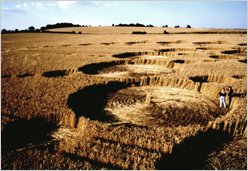 |  | 

I pointed out that the Stonehenge Julia Set had evidently appeared in broad daylight, in a span of perhaps 45 minutes.
RD: "That isn't true," Rod insisted. "It was made the previous night, by three people, in about two and three-quarters hours, starting around 2:45 am (on Sunday morning, July 7). It was there all that day. When that doctor flew over, he just didn't see it the first time. That happens a lot. His report was wrong. He just didn't see it."
ML: "You mean, it sat there next to that highway all day, and no one saw it? Are you kidding?"
RD: "If you went there, you'd see how the field slopes down and away from the road. The formation was in a kind of bowl, below the level of the road. Going by in a car, you couldn't see it. You would have to get out and walk toward it and look down into that bowl-shaped area to see it."
ML: "But there is a lot of air traffic in that area. Planes must have flown over it many times that day."
RD: "Sure, but lots of them just didn't see it, and the rest didn't think to report it, until that doctor reported it in the evening. I know this can happen, because I've made quite a few big formations and then waited for a day, even several days, before they're discovered."
ML: "OK, so you say that the Stonehenge Julia Set was created in less than three hours, in pitch darkness, by three people, and you know who they are...
RD: "Yes"
ML: "Can you tell me how this was done? This wasn't a free-hand glyph. They must have had a diagram or something..."
RD: "Yes, they had a diagram."
ML: "It has a very precise geometry, following a Fibonacci series..."
RD: "Well, for the first three-quarters of its arc, it does follow a Fibonacci series,* but the last quarter doesn't. It just becomes a circular arc."
That stopped me for a moment, because it was such a precise bit of information, so confidently delivered. Sensing my interest, he asked for a piece of paper from my note pad and drew a rough sketch.
RD: "Even if I didn't know who did this, I would have guessed it was made by people because of how they did it," he explained. "You start with the large central circle, which is placed right next to a tram line. People asked why it had the large central circle, which is a little out of place in a Julia Set. Simple.  To avoid damaging surrounding crop, you have to have a large central area already layed down, from which you can measure out diameters to other parts of the formation. After making the first circle, they measured out a work line for the rest of the formation. This is how the spiral was made, drawing portions of the arc from different center points inside that first circle, using a tape measure." He continued making his sketch as he spoke. "You keep moving the center point around that first circle, and lengthen the tape for each new part of the arc. You make the work line by just stepping down the grain with your feet, just a thin line. All the centers of all the main circles in the formation are along that line." To avoid damaging surrounding crop, you have to have a large central area already layed down, from which you can measure out diameters to other parts of the formation. After making the first circle, they measured out a work line for the rest of the formation. This is how the spiral was made, drawing portions of the arc from different center points inside that first circle, using a tape measure." He continued making his sketch as he spoke. "You keep moving the center point around that first circle, and lengthen the tape for each new part of the arc. You make the work line by just stepping down the grain with your feet, just a thin line. All the centers of all the main circles in the formation are along that line."
I began to realize that he was describing a perfectly feasible way to create such a complex formation. Looking at a good photo of the Stonehenge Julia Set after our discussion, I could clearly see what appeared to be the work line along the spine of the formation. Why would a paranormal force -- or an alien -- need such a line? Still, even for seasoned circle makers, the Julia Sets would be a major challenge (if they're really man-made). But Rod assured me that he and the others had had plenty of practice.
RD: "I can definitely account for most of the major pictograms [in England] from 1991 on," he said. "I myself made several dozen of them, although only a handful this year."
ML: "Do you think any of the large pictograms are anomalous?" I asked him.
RD: "I don't think so. Not since 1989, anyway, which is when I started observing the makers. I think all the big pictograms were made by people."
ML: "Crop circle researchers often observe that the crops are layered and laid down in alternating directions and so forth," I said. "How does that happen?"
RD: "These are just artifacts of the process," Rod answered. "If we're working from the center of a circle outward, for example, the crop splays out and tends to form spiral layers. It just happens that way."
ML: "What tools do you prefer? Rollers? Boards?"
* Fibonacci series: a progression of numbers in which each number is the sum of the two preceding numbers: 0, 1, 1, 2, 3, 5, 8, 13, 21, 34, etc.; discovered by Leonardo Fibonacci in the 13th century. Many spiral curves found in nature follow a Fibonacci series.
[ Page two of three ]
|  |  |





